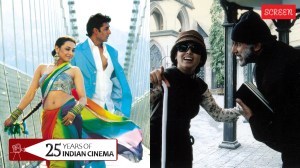Stay updated with the latest - Click here to follow us on Instagram
Chitrangada comes calling
Chitrangada was first dramatised in 1939,and ever since has been staged year after year by the Repertory.
Tagores path-breaking dance-drama from the Twenties to be staged in the city
The strains of Rabindra Sangeet fill the hall of Tagore Theatre as the students and teachers of Sangeet Bhavana,from Shantiniketans Visva-Bharati Repertory,rehearse for the big evening to stage the dance-drama Chitrangada,written by Rabindranath Tagore in 1923.
The staging is a part of Tagores 150th anniversary celebrations. Chitrangada was first dramatised in 1939,and ever since has been staged year after year by the Repertory. This year is special. So we went back to the archives to cull out photographs of costumes,sets,make-up and stage craft as conceived by Tagore and designed by celebrated artist Nandlal Bose. We have tried to get the same look and feel, explain Sangeet Bhavans professors Indrani Mukhopadhyay and Swastika Mukherjee,who are directing the play,along with Prof Sandip Basu.
Based on a story from the Mahabharata,the dance-drama is a woman-oriented play. Basu says,Written almost 80 years ago,the play depicts Tagores concerns for a womans identity,her position in the society and her search for love.
His vision and themes are as relevant today as they were decades ago. Perhaps,thats why his works are staged all over the world, he adds.
Retaining Tagores original idea of a dance-drama,they have incorporated Manipuri and Kathakali dance forms and indigenous musical instruments. Mukhopadhyay says Rabindra Nritya is unique,since Tagore blended Indian classical dances and matched them with characters to create a unique blend.
Since the copyright expired in 2000,maintaining the originality of his works is getting tougher,says Mukherjee. In the name of experimentation,people are adding new tunes to his songs,changing notations,staging his works with folk and Western motifs.
At Shantiniketan,however,the effort is to to be true to the Tagore tradition. Observers of Tagores art are happy that the audience appreciates their effort. We are nurturing what we got from Shantiniketan. Tagores works are an interplay of various traditions,ideas,philosophy and ambience,which we show to the world year after year, says Bose.







